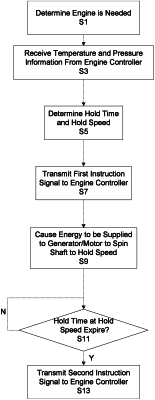| CPC F02D 31/007 (2013.01) [B60K 6/24 (2013.01); B60K 6/26 (2013.01); B60K 6/28 (2013.01); F02M 31/02 (2013.01); F02N 11/04 (2013.01); F02P 19/02 (2013.01); B60K 2006/268 (2013.01); F02N 2200/024 (2013.01); F02N 2200/121 (2013.01)] | 20 Claims |

|
1. A system for a hybrid electric vehicle comprising:
a generator/motor mechanically couplable to a crankshaft of an internal combustion engine;
a rechargeable energy storage device in communication with the generator/motor;
a second processor configured to determine when to start the internal combustion engine, cause energy to be supplied to the generator/motor to cause the generator/motor and crankshaft to rotate to at least a hold speed, transmit a first instruction to a first processor when determining that the internal combination engine should be started, whereby the first processor does not supply fuel to at least one cylinder of the internal combustion engine in response to the first instruction; and transmit a second instruction to the first processor after a variable period of time has elapse after the generator/motor or crankshaft has reached at least the hold speed, the variable period of time being based at least on a temperature measurement, wherein in response to the second instruction, the first processor enables fuel to be supplied to the internal combustion engine;
and a memory device configured to store relationships between a plurality of temperatures and a plurality of periods of time, respectively, wherein the second processor is configured to select one of the plurality of periods of time based on a sensed temperature and set the selected one of the plurality of periods of time as the variable period of time
wherein the second processor further receives pressure information for at least one fluid, and the second processor adjusts the selected one of the plurality periods of time based on the received pressure information for at least one fluid prior to setting the selected one of the plurality of periods of time as the variable period of time, and sets the adjusted period of time as the variable period of time.
|